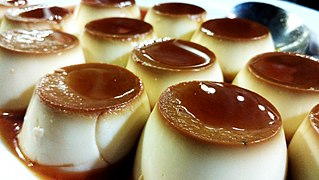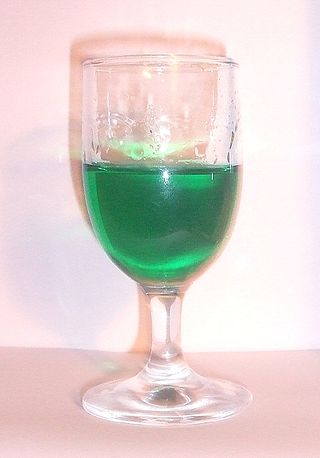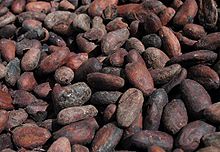
Chocolate is a food made from roasted and ground cocoa beans that can be a liquid, solid, or paste, either on its own or as a flavoring in other foods. The cacao tree has been used as a source of food for at least 5,300 years, starting with the Mayo-Chinchipe culture in what is present-day Ecuador. Later, Mesoamerican civilizations consumed cacao beverages, of which one, chocolate, was introduced to Europe in the 16th century.

Dessert is a course that concludes a meal. The course consists of sweet foods, such as cake, biscuit, ice cream and possibly a beverage such as dessert wine and liqueur. Some cultures sweeten foods that are more commonly savory to create desserts. In some parts of the world there is no tradition of a dessert course to conclude a meal.

A chocolate bar is a confection containing chocolate, which may also contain layerings or mixtures that include nuts, fruit, caramel, nougat, and wafers. A flat, easily breakable, chocolate bar is also called a tablet. In some varieties of English and food labeling standards, the term chocolate bar is reserved for bars of solid chocolate, with candy bar used for products with additional ingredients.

Crème caramel, flan, caramel pudding, condensed milk pudding or caramel custard is a custard dessert with a layer of clear caramel sauce.

Amaretto is a sweet Italian liqueur originating from the comune (municipality) of Saronno. Depending on the brand, it may be made from apricot kernels, bitter almonds, peach stones, or almonds, all of which are natural sources of the benzaldehyde that provides the almond-like flavour of the liqueur. It generally contains 21 to 28 percent alcohol by volume.

Hot chocolate, also known as hot cocoa or drinking chocolate, is a heated drink consisting of shaved or melted chocolate or cocoa powder, heated milk or water, and usually a sweetener. It is often garnished with whipped cream or marshmallows. Hot chocolate made with melted chocolate is sometimes called drinking chocolate, characterized by less sweetness and a thicker consistency.

Dutch processed cocoa, Dutch cocoa, or alkalized cocoa, is cocoa solids that have been treated with an alkalizing agent to reduce the natural acidity of cocoa, giving it a less bitter taste compared to "natural cocoa" extracted with the Broma process. It forms the basis for much of modern chocolate, and is used in ice cream, hot chocolate, and baking.
Apéritifs and digestifs are drinks, typically alcoholic, that are normally served before and after a meal respectively.

Crème de Noyaux is an almond-flavored crème liqueur, although it is actually made from apricot kernels or the kernels of peach or cherry pits, which provide an almond-like flavor. Both Bols and Hiram Walker produce artificially colored red versions of the liqueur while Noyau de Poissy from France is available in both clear (blanc) and barrel-aged amber (ambre) versions.

Ratafia is a broad term used for two types of sweet alcoholic beverages, a flavouring essence whose taste resembles bitter almonds, later to a ratafia flavoured biscuit, a biscuit to be eaten along with ratafia, and later still, to a cherry variety.

Crème de menthe is a sweet, mint-flavored alcoholic beverage. It is available commercially in a colorless version and a green version. Both varieties have similar flavor and are interchangeable in recipes, except where color is important. It is usually made with Corsican mint or peppermint, which is steeped in grain alcohol for several weeks before it is filtered and sweetened to create the final product. It typically has 25% alcohol by volume.

Chocolate cake or chocolate gâteau is a cake flavored with melted chocolate, cocoa powder, or both. It can also have other ingredients such as fudge, vanilla creme, and other sweeteners.

Whipped cream, also known as Chantilly cream or crème Chantilly, is high-fat dairy cream that has been aerated by whisking until it becomes light, fluffy, and capable of holding its shape. This process incorporates air into the cream, creating a semi-solid colloid. It is commonly sweetened with white sugar and sometimes flavored with vanilla. Whipped cream is often served on desserts and hot beverages, and used as an ingredient in desserts.

A Grasshopper is a sweet, mint-flavored, after-dinner drink named for its green color, which comes from crème de menthe. Tujague's, a bar in the French Quarter of New Orleans, Louisiana, claims its owner Philip Guichet invented the drink in 1918. The drink gained popularity during the 1950s and 1960s throughout the American South.

The Alexander is a cocktail consisting of cognac, crème de cacao, and cream. It dates from the early 20th century. It was originally made with gin, but the modern version is made with brandy and is called a Brandy Alexander.

A polar bear, After Eight or Peppermint Paddy is a mint chocolate cocktail that tastes like a York Peppermint Pattie or an After Eight mint. It is usually made from crème de cacao and peppermint schnapps, although crème de menthe is a popular substitute.
The following outline is provided as an overview of and topical guide to chocolate:

Vanilla is frequently used to flavor ice cream, especially in North America, Asia, and Europe. Vanilla ice cream, like other flavors of ice cream, was originally created by cooling a mixture made of cream, sugar, and vanilla above a container of ice and salt. The type of vanilla used to flavor ice cream varies by location. In North America and Europe consumers are interested in a more prominent, smoky flavor, while in Ireland, a more anise-like flavor is desired. To create the smooth consistency of ice cream, the mixture has to be stirred occasionally and then returned to the container of ice and salt to continue the solidification process. According to Iced: 180 Very Cool Concoctions, many people often consider vanilla to be the "default" or "plain" flavor of ice cream.

Dark chocolate is a form of chocolate made of cocoa solids, cocoa butter and sugar. Without added sweetener, dark chocolate is known as bitter chocolate or unsweetened chocolate. Dark chocolate, above white and milk chocolate, is valued for claimed, albeit unsupported health benefits and for being a sophisticated choice of chocolate. Like milk and white chocolate, dark chocolate is used to make chocolate bars and as a coating for confectionery.


















